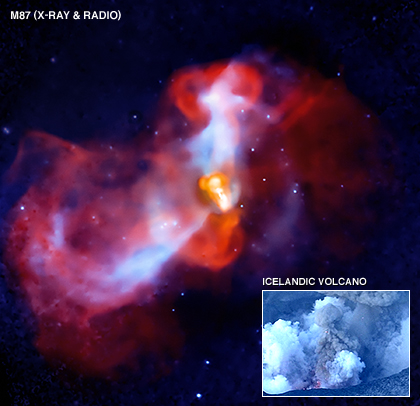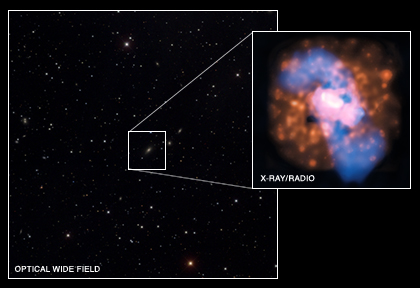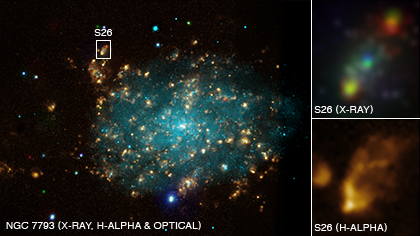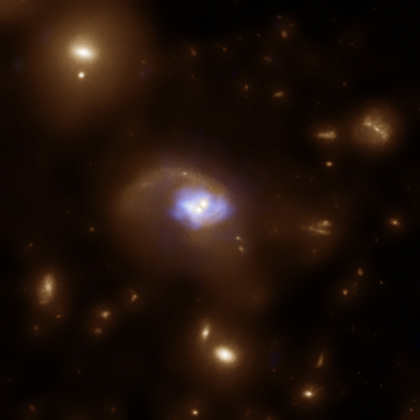Galactic Super-volcano in Action
This image shows the eruption of a galactic "super-volcano" in the massive galaxy M87, as witnessed by NASA's Chandra X-ray Observatory and NSF's Very Large Array (VLA). At a distance of about 50 million light years, M87 is relatively close to Earth and lies at the center of the Virgo cluster, which contains thousands of galaxies.
Image Genetics: Astronomy Visualization Metadata (AVM)
A random image of a mountainous landscape may be beautiful, but without some context and background information, i.e. metadata, you will likely have no idea where in the world the picture was taken, or even exactly what it is that you're looking at. Questions such as "How tall is that mountain?" "How far away is it from the photographer?" or "Where and when was this picture taken?" are all virtually impossible to answer just by looking at the image.
A Surprisingly Quiet Sun
In my last entry I described that particles coming out of the Sun -- especially what we call "soft" protons -- can damage the CCDs that we use on-board Chandra to detect X-rays. Because of this, we use a complicated network of on-board, space-based and ground-based monitors to ensure that the ACIS detector doesn't see too many of these protons. When the Sun was active, we often shut down the detector so that no damage would occur. Due to the solar cycle hitting a down phase, called "solar minimum," we haven't had to shutdown the detectors since 2006.
A Galactic Spectacle
A beautiful new image of two colliding galaxies has been released by NASA's Great Observatories. The Antennae galaxies, located about 62 million light years from Earth, are shown in this composite image from the Chandra X-ray Observatory (blue), the Hubble Space Telescope (gold and brown), and the Spitzer Space Telescope (red). The Antennae galaxies take their name from the long antenna-like "arms," seen in wide-angle views of the system. These features were produced by tidal forces generated in the collision.
Chandra at the 2010 Folklife Festival
The 2010 Smithsonian Folklife Festival wrapped up earlier this month on the National Mall in Washington, DC. This year, the Festival included the themes of the Smithsonian’s new Strategic Plan. Of course, Chandra and its role at the Smithsonian Astrophysical Observatory fit squarely into the goals of the “Mysteries of the Universe” theme. Therefore, it was very exciting for us to have a presence during this giant event.
Image Processor for a Day
The openFITS project represents a step towards removing some of the mystery surrounding image processing of the X-ray data from the Chandra Observatory. As the Science Imager for Chandra, I'm often asked if astronomical objects appear in optical images as they would if we could somehow fly to these objects and view them with our own eyes. Of course, this is usually asked in relation to optical images, such as those from Hubble, because human eyes cannot actually see X-rays!
Here Comes the Sun
Ok, I know this is not an original title for a blog about the sun and certainly not for the new solar cycle. Hey, I am an astronomer, not a writer. Like most science, my work on the Sun is partially something I fell into. My job on the Chandra science team is Monitoring and Trends Scientist. This means that it is my job to watch the spacecraft and make sure nothing is going to go wrong. To be honest, there are a whole bunch of engineers who have the same job for a specific part of the spacecraft and a chief engineer who monitors the whole spacecraft.
A Black Hole Slingshot?
Evidence for a recoiling black hole has been found using data from the Chandra X-ray Observatory, XMM-Newton, the Hubble Space Telescope (HST), and several ground-based telescopes. A new paper reports that this black hole kickback was caused either by a slingshot effect produced in a triple black hole system, or from the effects of gravitational waves produced after two supermassive black holes merged a few million years earlier.




